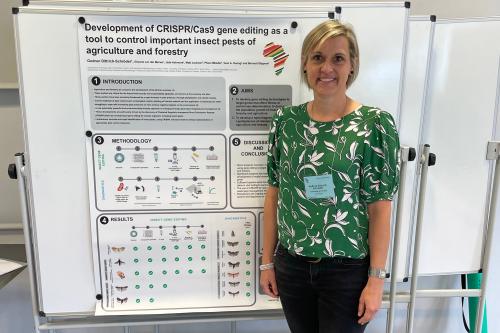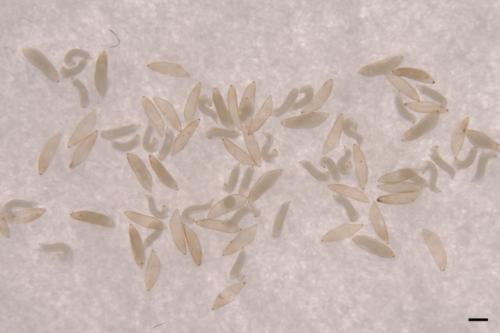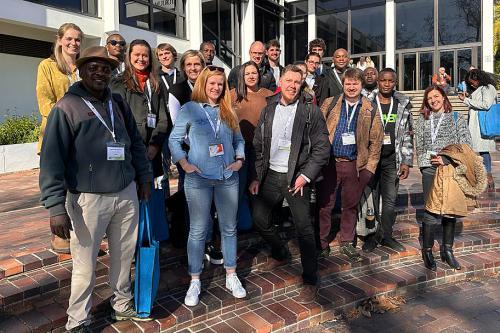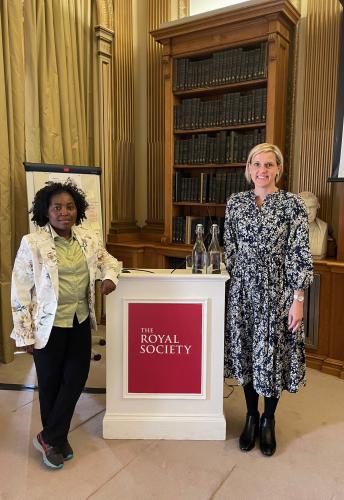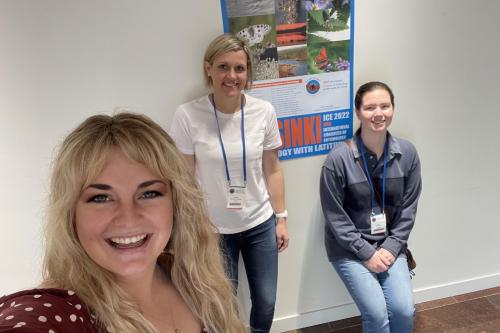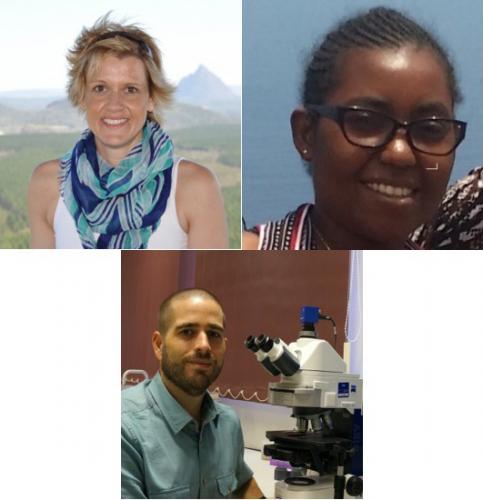Dr Gudrun Dittrich-Schroder
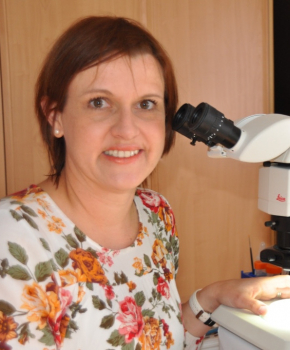
| Research Fellow | |
Department |
|
Zoology and Entomology |
|
| This email address is being protected from spambots. You need JavaScript enabled to view it. |
Research Profiles
My Students
| Primary Supervisor |
| Jade Ashmore |
My Links
Background
I completed a BSc (Agriculture) at the University of KwaZulu-Natal, Pietermaritzburg. Thereafter I conducted research in collaboration with the South African Sugarcane Research Institute (SASRI), Mount Edgecombe, Durban on Scarabaeids as well as a potential biocontrol agent of the stalk borer, Eldana saccharina. My MSc focused on identifying Scarabaeid larvae, problematic in sugarcane, by using molecular techniques to link unidentified larvae to identified beetles. Subsequently, a field key and electronic key, using Lucid 3.4 software, were developed to allow identification of larvae in sugarcane fields.
My PhD was conducted at FABI, the University of Pretoria, focusing on the molecular ecology and management of Leptocybe invasa (Hymenoptera: Eulophidae) in South Africa. Leptocybe invasa is a minute gall-forming wasp and an emerging pest of Eucalyptus spp. throughout the world and has become one of the most threatening insect pests to Eucalyptus plantation forestry.
Combined analyses of sequence data from the mitochondrial cytochrome oxidase I gene region and simple sequence repeat markers revealed two distinct lineages amongst global populations of L. invasa. One of these lineages corresponded to the originally described L. invasa, and is present in most populations around the world. The second lineage occurred in specimens mostly from Asia, with the exception of Ghana, and is most similar to currently known native populations from Australia. There was little genetic diversity within the two lineages in invasive populations, and they appeared to represent at least two introductions. The native Australian population was found to have a relatively high level of genetic diversity.
The primary control options for L. invasa are biological control and deployment of tolerant/resistant Eucalyptus species or hybrid clones. Collection of galled Eucalyptus tissue in Australia yielded large numbers of an undescribed hymenopteran, which was subsequently described as Selitrichodes neseri (Hymenoptera: Eulophidae). The biology of this wasp and its suitability as a potential biological control agent was studied, including host specificity and evaluating its potential impact as a parasitoid of L. invasa. The second important method of control is the breeding or selection of tolerant/resistant Eucalyptus material. Work conducted in this study compared the susceptibility of commercially available, as well as company specific Eucalyptus clones and species to attack by L. invasa. Considerable variation was observed between genotypes of Eucalyptus species, illustrating the potential of host resistance for management.
Current research
I am a recipient of the Future Leaders-African Independent Research (FLAIR) Fellowship, which is a partnership between the African Academy of Sciences (AAS) and The Royal Society, supported by the Global Challenges Research Fund (GCRF).
My research will entail the development and application of CRISPR/Cas9 gene editing tools to control major insect pests of agriculture and forestry. Agriculture as well as forestry are crucial to the development of the African economy as a whole and provide significant employment opportunities. These sectors are critical for future food security, drivers of the economy and are critically linked to jobs. One of the single biggest threats to the agricultural and forestry sectors are pests and diseases. Current control measures cannot keep pace with the increase in pests and diseases. A new possibility to manage invasive pest using gene editing technologies exists. Gene editing tools allow the targeting of exact changes in an organisms DNA to affect certain traits. By targeting traits that affect fitness of the organism, or the mechanism through which it causes harm, its impact could be reduced. These tools can theoretically be applied in a much wider variety of organisms than previously possible, making it feasible to consider its use as part of a pest control strategy.

News
FABI Research Fellow Dr Gudrun Dittrich-Schröder attended the International Society for Biosafety Research Symposium in Ghent, Belgium
From the 19-25 May Dr Gudrun Dittrich-Schröder attended the Gordon Research Conference (GRC) in Spain.
The newly-developed Sirex egg activation technique, developed by FABI researchers, is highlighted in a news item by Nature Africa.
Twenty four FABIans attended and presented at the recent 23rd Congress of the Entomological Society of Southern Africa.
Prof. Bernard Slippers and Dr Gudrun Dittrich-Schröder met with researchers and students at Imperial College London during a recent visit to London.
Two FABI FLAIR Fellows attended meetings at the Royal Society in London.
Three FABIans attended the 26th International Congress of Entomology (ICE) from 17-22 July, in Helsinki, Finland.
The FABI community is delighted with three of its researchers awarded Future Leaders – African Independent Research (FLAIR) fellowships.
My Book Chapters
| Book Chapters |
|---|
| Hurley BP, Dittrich-Schröder G, Gevers C. 2023. Gall Formers. In: Forest Entomology and Pathology Vol.1. Allison JD, Paine TD, Slippers B, Wingfield MJ. (eds). Springer, Cham, Switzerland, pp 457-494. |
My Journal Articles
| Publication |
|---|
| van der Merwe E, Slippers B, Dittrich-Schröder G. (2025) Exploring artificial diets for the laboratory rearing of Sirex noctilio late-instar larvae: a qualitative study. Zenodo
10.5281/zenodo.15049303 |
| Ashmore JS, Slippers B, Duong TA, Dittrich-Schröder G. (2024) Understanding the genetics of sex determination in insects and its relevance to genetic pest management. Insect Molecular Biology
10.1111/imb.12982 |
| van der Merwe E, Slippers B, Dittrich-Schröder G. (2023) Mechanical egg activation and rearing of first instar larvae of Sirex noctilio (Hymenoptera: Siricidae). Insects 14(12):931.
https://www.mdpi.com/2075-4450/14/12/931 |
| Dittrich-Schröder G, Garnas JR, Arriagades-Cares D, Ahumada R, Hurley BP, Lawson SA, Slippers B. (2021) Diversity and Introduction History of Glycaspis brimblecombei Reflects a History of Bridgeheads and Distinct Invasions. Frontiers in Forests and Global Change 4:1-11.
10.3389/ffgc.2021.783603 |
| Gevers CR, Slippers B, Germishuizen I, Dittrich-Schröder G, Hurley BP. (2021) The distribution and diversity of Leptocybe invasa (Hymenoptera: Eulophidae) and its gall associates in South Africa. Southern Forests
10.2989/20702620.2021.1944395 |
| Gevers CR, Dittrich-Schroder D, Slippers B, Hurley BP. (2020) Interactions between hymenopteran species associated with gall-forming wasps: the Leptocybe invasa community as a case study. Agricultural and Forest Entomology
10.1111/afe.12413 |
| Bush SJ, Slippers B, Dittrich-Schröder G, Hurley BP. (2020) Host specificity tests reveals new host of a global biological control agent Psyllaephagus bliteus (Hymenoptera: Encyrtidae). African Entomology 28:238-248.
10.4001/003.028.0238 |
| Dittrich-Schröder G, Hurley BP, Wingfield MJ, Nahrung HF, Slippers B. (2020) Invasive gall-forming wasps that threaten non-native plantation-grown Eucalyptus: diversity and invasion patterns. Agricultural and Forest Entomology
10.1111/afe.12402 |
| Dittrich-Schröder G, Hoareau TB, Hurley BP, Wingfield MJ, Lawson S, Nahrung HF, Slippers B. (2018) Population genetic analyses of complex global insect invasions in managed landscapes: a Leptocybe invasa (Hymenoptera) case study. Biological Invasions 20(9):2395-2420.
10.1007/s10530-018-1709-0 |
| Bush SJ, Dittrich-Schröder D, Neser S, Gevers C, Baffoe KO, Slippers B, Hurley BP. (2018) First record of Quadristichus mendeli, a parasitoid of Leptocybe invasa, in South Africa. Southern Forests
10.2989/20702620.2017.1318347 |
| Bush SJ, Slippers B, Neser S, Harney M, Dittrich-Schröder G, Hurley BP. (2016) Six recently recorded Australian insects associated with Eucalyptus in South Africa. African Entomology 24(2):539-544.
10.4001/003.024.0539 |
| Klein H, Hoffmann J H, Neser S, Dittrich-Schroder G. (2015) Evidence that Quadrastichodella nova (Hymenoptera: Eulophidae) is the only gall inducer among four hymenopteran species associated with seed capsules of Eucalyptus camaldulensis (Myrtaceae) in South Africa. African Entomology 23(1):207-223.
|
| Dittrich-Schroder G, Harney M, Neser S, Joffe T, Bush S, Hurley BP, Wingfield MJ, Slippers B. (2014) Biology and host preference of Selitrichodes neseri: A potential biological control agent of the Eucalyptus gall wasp, Leptocybe invasa. Biological Control 78:33-41.
10.1016/j.biocontrol.2014.07.004 |
| Dittrich-Schröder G, Hurley BP, Wingfield MJ, Slippers B. (2012) Diversity in Eucalyptus susceptibility to the gall-forming wasp Leptocybe invasa. Agricultural and Forest Entomology 14:419-427.
10.1111/j.1461-9563.2012.00583.x |
| Dittrich-Schroder G, Wingfield MJ, Klein H, Slippers B. (2012) DNA extraction techniques for DNA barcoding of minute gall-inhabiting wasps. Molecular Ecology Resources 12:109-115.
|
| Kelly J, La Salle J, Harney M, Dittrich-Schröder G, Hurley BP. (2012) Selitrichodes neseri n. sp., a new parasitoid of the eucalyptus gall wasp Leptocybe invasa Fisher & La Salle (Hymenoptera: Eulophidae: Tetrastichinae). Zootaxa 3333:50-57.
|
| Dittrich G, Conlong DE, Mitchell A. (2006) Genetic diversity of Sturmiopsis parasitica Curran (Diptera: Tachinidae). Annales de la Societe entomologique de France 42:325-329.
|



